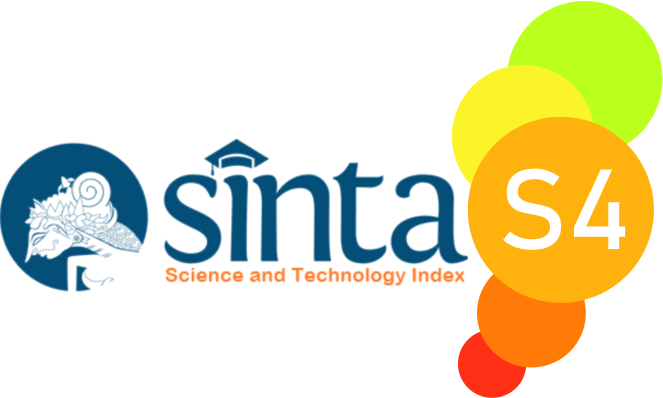An Analysis of the Students’ Perception on Using Google Classroom for Learning English
Abstract
This study investigated the students' peception on using Google Classroom (GC) for learning English at SMAN 2 Sungai Raya. This research was a descriptive study with a quantitative approach; survey method involving 146 eleventh grade students at SMAN 2 Sungai Raya. The data were analyzed using descriptive statistics for the close-ended questions, which calculated the mean score of the questions and thematic analysis for the open-ended questions. The findings were presented the total mean score of five indicators of close-ended questions and distribution frequency table based on the theme of open-ended questions. The result presented that the total mean score of each indicators showed positive responses. Those were the usefulness of GC features (M=3.72), the ease of use of the features to motivate the students (M=3.71), Students’ participation (M=3.66), and students’ satisfaction (M=3.54). These can be approved by the students’ statements that learning English using GC was fun and improved their English reading and writing skills. The result showed that students had positive perceptions towards the use of GC. It facilitated them with the usefulness features, ease of use, and satisfied them with the accessibility. However, the GC had some limitations in terms of the communication and collaborative learning English.
References
Froemling, K. K., Grice, G. L., & Skinner, J. F. (2011). Communication: The handbook. Allyn & Bacon.
Han, J.-H., & Sa, H. J. (2021). Acceptance of and satisfaction with online educational classes through the technology acceptance model (TAM): The COVID-19 situation in Korea. Asia Pacific Education Review.doi: https://doi.org/10.1007/s12564-021-09716-7
Henukh, A., & Astra, I. M. (2021). The use of Google classroom as ICT literacy to improve physics students collaboration skill in industrial revolution 4.0. 030002. doi: https://doi.org/10.1063/5.0041660
Islam, S. M. (2019). Bangladesh university students’ perception on using Google Classroom for teaching English. International Journal of Psycho-Educational Sciences, 8(2), 75–65.
Johns, G., & Saks, A. M. (2017). Organizational behaviour: Understanding and managing life at work (Tenth edition). Pearson.
Kemendikbud. (2020). Kemendikbud Terbitkan Pedoman Penyelenggaraan Belajar dari Rumah. https://www.kemdikbud.go.id/main/blog/2020/05/kemendikbud-terbitkan-pedoman-penyelenggaraan-belajar-dari-rumah
Kim, Gyoo-mi, & Lee, Sang-jun. (2016). Korean Students’ Intentions to Use Mobile-Assisted Language Learning: Applying the Technology Acceptance Model. International Journal of Contents, 12(3), 47–53. doi:https://doi.org/10.5392/IJOC.2016.12.3.047
Kreitner, R., & Kinicki, A. (2010). Organizational behavior (9th ed). McGraw-Hill/Irwin.
Laili, E., & Muflihah, T. (2020). The Effectiveness of Google Classroom in Teaching Writing of Recount Text for Senior High Schools. JOLLT Journal of Language and Language Teaching, 8(4), 348–359.doi: https://doi.org/10.33394/jolt.v%vi%i.2929
Lee, J.-W. (2010). Online support service quality, online learning acceptance, and student satisfaction. The Internet and Higher Education, 13(4), 277–283. doi:https://doi.org/10.1016/j.iheduc.2010.08.002
Mahyoob, M. (2020). Challanges of e-Learning during the Covid-19 pandemic experienced by EFL learners. Arab World English Journal, 11(4), 351–362. doi:https:/dx.doi.org/10.24093/awej/vol11no4.23
Okmawati, M. (2020). The Use of Google Classroom during Pandemic. Journal of English Langauge Teaching, 9(2), 438–443.
Ramli, N., Muljono, P., & M. Afendi, F. (2018). External factors, internal factors and self-directed learning readiness. Journal of Education and E-Learning Research, 5(1), 37–42.doi: https://doi.org/10.20448/journal.509.2018.51.37.42
Robbins, S. P., & Judge, T. (2013). Organizational behavior (15th ed). Pearson.
Setiyani, L. (2021). Using Technology Acceptance Model 3 (TAM 3) at Selected Private Technical High School: Google Drive Storage in E-Learning. Utamax : Journal of Ultimate Research and Trends in Education, 3(2), 80–89. doi: https://doi.org/10.31849/utamax.v3i2.6746
Shaughnessy, J. J., Zechmeister, E. B., & Zechmeister, J. S. (2012). Research methods in psychology (9th ed). McGraw-Hill.
Suryani, N. Y., Rizal, S., & Rifa’at, A. A. (2021). Nursing students’ perception of the Use of Google Classroom in TOEFL Preparation. Attractive : Innovative Education Journal, 3(2), 102.doi: https://doi.org/10.51278/aj.v3i2.224
Taat, M. S., & Francis, A. (2019). Factors Influencing the Students’ Acceptance of E-Learning at Teacher Education Institute: An Exploratory Study in Malaysia. International Journal of Higher Education, 9(1), 133. doi: https://doi.org/10.5430/ijhe.v9n1p133
Wan Azli, W. U. A., Shah, P. M., & Mohamad, M. (2018). Perception on the Usage of Mobile Assisted Language Learning (MALL) in English as a Second Language (ESL) Learning among Vocational College Students. Creative Education, 09(01), 84–98.doi: https://doi.org/10.4236/ce.2018.91008
Winarti, M., Nurhasanah, A., & Ningsih, R. (2020). Utilizing Google Classroom: Pros and Cons for a High School English Teacher in Jambi. ELITE Journal, 2(2), 173–184..
Yunita, V. M., Sunardi, & Agus, K. (2021). Special education teachers’ perception toward online learning during the Covid-19 pandemic. Jurnal Pendidikan Indonesia, 10(2), 33–41.doi: https://doi.org/10.23887/jpi-undiksha.v10i2.29773
Copyright (c) 2022 Asma Ul Husna. H, Rahayu Apriliaswati, Surmiyati Surmiyati

This work is licensed under a Creative Commons Attribution-ShareAlike 4.0 International License.

Journey: Journal of English Language and Pedagogy by http://ejurnal.budiutomomalang.ac.id/index.php/journey/index is licensed under a Creative Commons Attribution-ShareAlike 4.0 International License.






